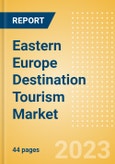Poland was the highest contributor (30.60% of overall international arrivals in the Eastern European region) followed by Hungary (20.69%). As Poland has become one of the safest countries, it is attracting tourists with its architecture, the city of Krakow, the Wieliczka salt mine, and the Tatra mountains all popular. On the same time Hungary's tourism industry had a significant upturn in 2022, with the number of overnight stays in the nation's accommodation rising by over 40% year over year to nearly 40 million. The country has established a goal of doubling the number of visitor nights in short-stay accommodations in 2030.
In 2022, leisure was the most common purpose of travel for arrivals in the region, accounting for 19.96 million travelers or 37.19% of overall international travels. This remained below pre-pandemic levels seen in 2019. For the period 2015 to 2019, overall international travelers for leisure purpose saw growth at a CAGR of 4.72%. Travelers aged 35-49 were the largest contributor of travelers to the Eastern European region which accounted for 31.37% of overall travelers (75.94 million travelers) in 2022 followed by travelers aged 25-34 with a contribution of 24.55% (59.42 million travelers) which is lower than the pre-pandemic level.
The report “Eastern Europe Destination Tourism Market Insight and Future Opportunities, 2023 Update” analyzes destination markets, infrastructure, and attractions, as well as risks and opportunities in Eastern Europe. This report explores the types of travelers that visit the region as well as a SWOT analysis.
Scope
This report is part of the publisher's Destination Market Insights Series. These reports provide an in-depth analysis of a tourist destination and its key source markets, as well as an assessment of the trends and issues in the covered destination market, in this case Eastern Europe.Reasons to Buy
- Obtain a clear and detailed insight into new developments in a highly popular tourist destination
- Use data and analysis to explore future trends related to international arrivals, airlines, niche tourism, and hotel developments
- Gain a strong understanding of the opportunities in the market, as well as the risks, to support better business decisions.
Table of Contents
- Overview
- Key Trends
- Tourism Construction Projects
- Foreign Direct Investment
- COVID-19 Impact
- Source Market
- Types of Tourism
- Destination Focus
- Risk & SWOT Analysis
- Appendix
Companies Mentioned (Partial List)
A selection of companies mentioned in this report includes, but is not limited to:
- Hotel Wozniak Resort & Spa
- Hyatt Hotels
- Marriott International
- B&B Hotels
- Russian Management Hotel Company
- Radisson Hotel Group








